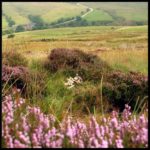Short Sterling LJ628.
‹ Return to Air Crash Sites

Short Sterling LJ628
21 July 1944
All 10 crew survived this crash. The Stirling was on a training exercise, the crew learning how to deal with stopped engines and such events. With attention concentrated on these details, the bomber had drifted off course and flew into Howden Moor in the Peak District. Pilot of the Stirling, Squadron Leader Hadland, had just enough time to pull back on the stick to reduce the blow as the aircraft struck the ground. Fortunately there was no fire.
Squadron Leader Hadland
Flying Officer J O’Leary
Flying Officer L Gardiner
Sergeant McDonald
Sergeant J Coulson
Sergeant J Gittings
Sergeant Ludlow
Sergeant T Burroughs
Sergeant L van Nierkirk (Royal Rhodesian Air Force)
Sergeant Austin (Royal Rhodesian Air Force)


below; Fragment of debris in a clough about 1km from the impact point.




Details from High Peak Air Crash Sites by Pat Cunningham (2010)
20 comments on “Short Sterling LJ628.”
Leave a Reply to Ian D B Cancel reply
Image Information
-
Full Size: 1314×812px
Aperture: f/8
Focal Length: 29mm
ISO: 200
Shutter: 1/160 sec
Camera: NIKON D40



Like the textures Ian , think they work best on the second shot .Helps bring out the colour on those panels and that Stirling shot is a beaut too
they certainly were big, i think they were pulled from service as bombers because they made such an easy target.
Great work again Ian
The main reason they were pulled from front line services was the fact that they could not reach effective altitude and were slow. The bomb load was poor and they were no match fro the Lancaster and Halifax that came along later. With tthe rushcto have an efective 4 engined bomber quickly Shorts "cobled" together a new design using the wings and engines from a Sunderland flying boat married to a new fusalage. The length of the bomb bay and CG of the aircraft gave a very long fusalage, that required extended undercarriage legs, giving that prounounced nose high attitude on the ground and also the need for extended undercarriage doors. as can been see in the photograph above. They proved perfectly adequate as Heavy Conversion unit aircraft, training crews to operate 4 engined bombers, such as the Lanc and Halifax. They also made good glider tugs and supply aircraft for dropping arms etc to resitance units in France and Jugoslavia. On operations early in the war they had a poor operational record that soon relagated them to 2nd line operations.
Good to read of surviors Ian ! These textures you’re using add even more to the poignancy of the peaty moorland crash sites.
great work ian three brilliant pictures
liking that texture work tooooooo mate…
Wonderful set of shots Ian
great story ian , great work
Good shot Ian, so sad when even a training exercise goes wrong!! Thank goodness all survived, it could have been so different!! Like all pics and the texture works so well!!!:)
The texture does add something.
I meant something good.
Photos made all the more poignant with the rendering of the shots, works well.
These things had the height of a one storey building, great looking aircraft.
Another good series Ian – another scattered set of debris by the looks
forum.keypublishing.com/showthread.php?t=77197&highli…
forum.keypublishing.com/showthread.php?t=90313
Hi Ian,
I’m currently researching Richard Lewis Ludlow on behalf of his daughter.He was a rear gunner on, we think Halifax’s or Lancasters.
His name is mentioned in the above crew but is it the same chap I’m researching? (no initalis?)I think it is.
Do you happen to know where the above aircraft t/o from and what squadron it beloned to.
May I have your permission to download the brilliant photos you have taken.
best regards Graham Adams. 17/10/2017
Hi Graham, I don’t know but will take a look for more info about Sgt Ludlow (Flight Engineer) in the books I have and let you know if they have any further details. I don’t think it likely there will be anything else, I always try to find out the crews’ names so would have only listed as Sgt Ludlow because all sources available would have not had other info. But it was 6 years ago, I might have something in some newer books. I expect the paucity of info is because all crew survived the crash.
Aircraft was with 1654 Heavy Conversion Unit, took off from RAF Wigsley in Nottinghamshire.
Grid ref; SK 20218 95590
Feel free to download and use the photos if you like, but please with a credit to aircrashsites.co.uk if you do? I have added a few more photos including the lead photo without that texture overlay which I liked at the time.
Ian
My Papa James Coulson was the Bomb Aimer on that plane. So thankful he survived or I wouldn’t be hear today
Hello I’m the youngest daughter of Richard Lewis ludlow I know he was in a air crash I have some hand written books by him if any interest to you.
Hi Cathy,
Lovely to hear from you. I have edited out your phone number as it can be viewed by anyone, you could gets lots of spam!
What are the books your father wrote?
Ian